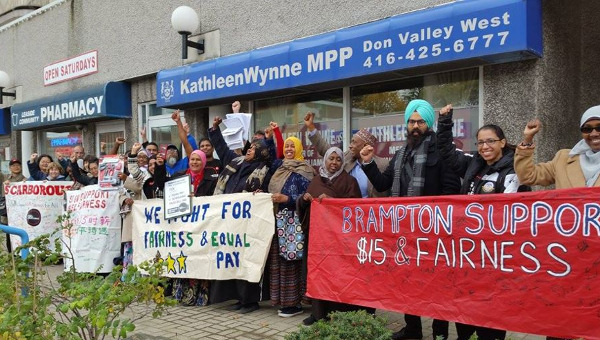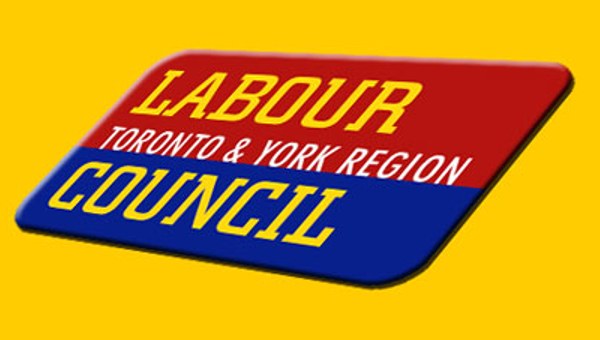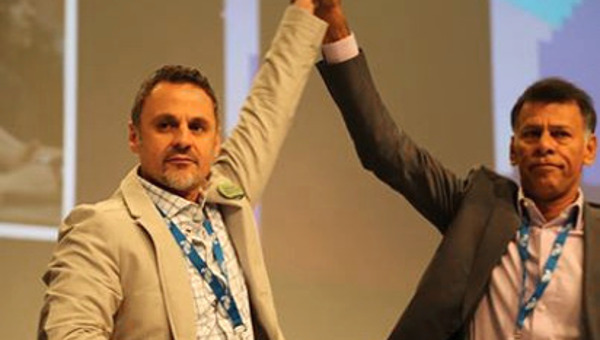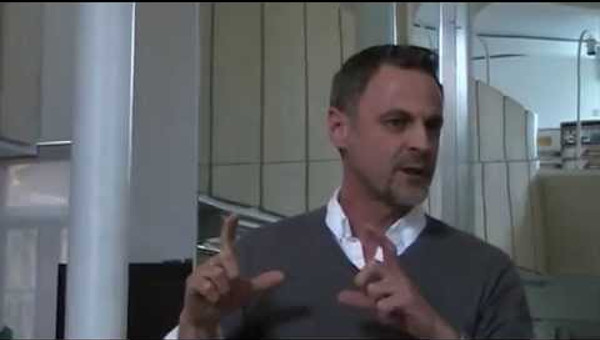‘Dare Anyone Say a Word?’: The CLC Convention of 2008
There is always something unsettling about people who say one thing and do another. There is for one thing the hypocrisy. Then, there is the uncertainty.
It only takes a few disappointments to sow the seeds of doubt about whether you can ever trust a person’s judgement again or whether you can ever expect them to fulfill their responsibilities in the future.
These problems become even greater when those in leadership positions engage in such ‘shambolic’ efforts that involve saying much and doing little, while rejecting all criticism. Couple this with trying to shut down any hints of debate or questioning of decisions or strategies, and what you end up with is a sort of variation on the ‘Emperor has no clothes’ fable.
All these problems were very much in evidence at the recent Canadian Labour Congress Convention in Toronto (May 26-30, 2008) and all of these problems raise serious red flags about the state of the Canadian labour movement today. But in a variation of the story, there was something even more staged and more malevolent about the Congress – more an event of the ‘Leader has no clothes, but I dare anyone to say anything about it.’
Even though there were many good resolutions dealing with renewing organizing, fighting privatization, establishing a national pharmacare program, and protecting and renewing good, unionized manufacturing jobs, there was very little to suggest that the Canadian Labour Congress (CLC) would play any effective role in pushing these policies forward.
Many of the final CLC resolutions suggested nothing more than future meetings with union staff to discuss options. Others only broached the importance of raising issues. Few detailed how a campaign would actually be launched. None made the promise that any money would be devoted to these causes.
Even more worrisome was that in the floor debates, there was a good deal of evidence that the CLC and many in leadership positions were more interested in trying to shut down discussion and shut down the kind of activism necessary to move progressive ideas forward, rather than trying to stir passions, raise public awareness, and mobilize workers across Canada.
The Canadian Labour Congress – Yesterday and Today
Outside of organized labour, the Canadian Labour Congress is a generally unknown entity to most Canadians. Established in 1956, its basic functions were to operate as a central public communication body for labour, lobby government behind the scenes, conduct research, and help educate workers in local and provincial labour councils across Canada.
The CLC was also established as the key fundraising arm and supporter for the NDP, something it continued to do until 2003, when federal financing laws cut at labour donations, while leaving large loopholes for corporate donations through individual and diffuse political action committees.
The CLC had a number of useful secondary functions. Among the most effective was organizing new members where it was most difficult to do so and where unions had less influence. Also important was the role the CLC played in the mid-1970s helping coordinate and organize a national general strike against wage and price controls, as well as strikes against inadequate economic policy and draconian public sector legislation.
Today, the CLC is a much more circumscribed organization, and it has more often than not accommodated to liberal market political reforms instead of actively trying to change them for the better.
The CLC no longer organizes workers, nor does it provide financing or political direction for union members across the country. Over the past ten years, under the leadership of Ken Georgetti, public campaigns have taken a backseat to attempts at lobbying parliamentary committees and house members to change a select few pieces of legislation. Attempts at organizing national strikes or national demonstrations have all but vanished.
To its credit, many of the CLC’s researchers do produce some of the best material on labour markets and economics around. But little of this material makes its way to members, and to the general public. It is almost wholly invisible.
‘Unions Now More than Ever?’
These changes have not been for the better, and it showed at the most recent convention in Toronto.
Ostensibly organized around the theme, ‘Unions! Now More than Ever!,’ on major debates, national union leaders were often missing. On other issues like national pharmacare or workers’ centres for agricultural workers, leaders and staff alike were busier with their Blackberries than with the events unfolding on the convention floor. Throughout the entire convention, most staff complained miserably that the congress was a complete waste of time, and left at the earliest possible time or for any modestly convenient reason.
The CLC also made nothing more than a blip in Canada’s biggest media market over an entire week – a mention in the National Post no less that Ken Georgetti was re-elected as president. This is more than a bit odd for a central labour body that claims to represent some three million unionized workers across Canada, with annual revenues of twenty million and a good-sized staff, and more than a few employed in communications and media relations.
Even more troubling were the actions of the three-time incumbent CLC President Ken Georgetti, who again ran uncontested for the president’s job. Whenever the debate took a turn Georgetti disliked, the speaker’s microphone was cut off. Whenever attempts were made to amend resolutions, he conveniently forgot all procedures for doing so. Whenever, questions began to be raised, he would move to cut off debate. Georgetti acted more like a leader under threat of an unseen conspiracy than the head of a democratic union organization.
For a labour leader, whose job it is to inspire and educate members, his performance was a curious mix – think Stéphane Dion channelling Mike Harris. It was hardly a demonstration of confident and assured leadership, and hardly a presentation of vision and charisma that most rational union delegates would think worthy of re-election for a fourth time.
Still, there were highlights. Laudable speeches by some of the most powerful and respected voices in labour such as by Paul Forder of the Canadian Auto Workers on organizing and the need for solidarity, toughmindedness and the will required for unions and the labour movement to grow in a way that benefits all, raised everyone to their feet.
Sid Ryan of the Canadian Union of Public Employees also perked up everyone’s ears with his speech about strikes and the right to strike, and how unions have had to use this basic tool of collective action, time and again to win the most minor as well as most major of gains, often in the face of police, repression, and arrest.
Also noteworthy was the Canadian Labour Congress giving Dr. Henry Morgentaler its highest honour, the Award for Outstanding Service to Humanity, for his contribution to the cause of equality and choice in reproductive rights for women. Less praiseworthy was the way in how the CLC handed out the award – in complete media lockdown that effectively barred any wider public comment or discussion.
Labour’s Problems
But if the week long convention did little to leave an impression that the current generation of leaders is up to the task of revitalizing unions, in discussions with workers and staff around the country, at least something of a picture is emerging in people’s minds of key problems facing the labour movement that have to be tackled now.
Chief among these is the growth in cheap labour. Today, across Canada, only fifty-four percent of jobs are full-time and full-year, and more than forty percent of all jobs can be classified as ‘low-wage’ – this includes part-time, temporary, and contract employment, as well as workers making less than fifty percent of the median wage. As disturbing are the forty-three hundred temp agencies currently set up in Canada, many of which employ people well below baseline employment standards of wages, hours, and basic benefits.
There are also now hundreds of thousands of workers on temporary work permits – all without the right to unionize. These workers are typically unprotected by basic employment standards, and the vast majority have little protection against accidents or sickness, and no access to any social programs – like health and unemployment assistance – despite paying taxes and EI premiums.
The second biggest problem facing the labour movement is closely related: the decline in union organizing and the failure of unions to adequately deal with increasingly restrictive, neoliberal legislation.
Over the past decade, union organizing in Canada has fallen off the map. The organizing of new union members has hit record fifty-year lows of 40,000 or so in over the past few years, less than a third of what is required if unions even want to tread water and keep up with employment growth. As a result, today only fifteen percent of those in private sector across Canada have union representation and protection. And with fewer members, there are of course, fewer resources for organizing.
A few workers and staff are beginning to realize the depth of the problem, and also the fact that as their unions decline, so too do their prospects for better wages and better deals from governments. But how to make this shift in resources and staff is a key political question, and one not easily answered because of the internal barriers internal many union activists face.
A third problem follows from this: political impasse: the lack of fresh thinking and the turn by many union leaders and staff to partnership deals with employers, usually based on giving concessions at the bargaining table in return for tissue-thin employer promises for jobs.
These problems have been prevalent throughout private sector industrial unions over the past few decades, but have been given even more prominence of late by the Canadian Auto Workers and their unprecedented deal with Frank Stronach and Magna auto parts.
In signing a deal that relinquishes the right to strike, bars the union from educating new members, and prevents the union from bargaining on workplace issues, the CAW has essentially ceded the tools needed for unions to improve wages and working conditions at Magna, and undercut any hope that future Magna agreements will lead to improvements elsewhere in Magna or in the auto parts sector.
More disquieting still is the very strong possibility that CAW’s Magna deal will set the new benchmark for all industrial employers, who will use the deal to seek more concessions from workers in everything from manufacturing to mining, transport to long-term care.
And when this isn’t enough, as GM showed last week, it is very easy indeed to pressure governments into coughing up millions of dollars, and then simply pocket the cash when you shut down a plant, saving millions in wages and capital costs.
Finally, the Canadian labour movement faces a fourth problem: the reality that workers deal with inside their own unions today of undemocratic structures and bureaucratic obstacles. These pose huge difficulties to overcome before any progressive action can be taken.
A common occurrence, for example, is that union leaders are opting for partnership deals with employers rather than effective mobilization and fight back strategies. More and more often, to sell these deals, union staff and leaders now regularly resort to fear tactics in their attempts to force through acceptance, telling members that unless they accept concessions they will lose their jobs. Globalization – the tale is commonly told – is the ogre in the room, and it brooks no dissent.
When this fails to convince, union leaders then move on to limiting debate at microphones, councils, and meetings, and all the while cutting education programs, and having staff ‘weed out the bad apples’ of those who speak out from union activities. These are tactics that are not all that different from what was in evidence throughout last week’s CLC convention.
Younger workers especially are beginning to realize that the undemocratic practice of shutting down debate solves nothing. At convention after union convention over the past few years, whether in the public or private sector you can meet young, energized, men and women interested in turning around their unions, and widening the public arena for debate and discussion on alternative mobilizing and organizing strategies.
This is a cause for optimism. For despite the extent of problems that many workers talk privately about, the fact remains that recognition is the first step towards dealing with the problems. It is also the case that when enough people want to do something to better, sooner or later a critical mass emerges to force the issues home.
An Action Agenda
John Cartwright might be one such labour leader who can provide a reason to think a better day might yet come to pass. Prior to the CLC convention, Cartwright – President of the Toronto and York District Labour Council – criss-crossed the country talking about the need for a new
‘Action Agenda.’
Recognizing the need for a plan that workers can get behind, Cartwright spoke eloquently of the need for real commitments to organizing, public campaigns to stop privatization, and the need for organized labour to lead rather than follow the debate for environmental sustainability.
His was an articulate and stirring message that can and should provide a starting point for debate. But it is also an agenda that too few have heard about and that many in the upper levels of the labour movement find challenging. It will also require many more to join in. Unfortunately, Cartwright had little impact in getting current union leadership to make real commitments to work for solutions at the CLC.
An agenda for change is more necessary than ever today. But what any agenda for change also requires is a template for how to make reforms within unions themselves as well as within union bodies like the CLC. In the long-run, it will not be enough to simply organize new members and launch more public campaigns. Rather what will be most important are the kinds of unions and the kinds of political party that workers and young activists can build and lead.
Throughout the post-war period, the growth of unions depended on strong parties of the left as well as unions expanding the number of political and educational opportunities so that workers could apply their learning for the collective good. Social equality depended on unions and left parties keeping capital in check and improving public services that benefited all. Political success depended on hard work, cooperation, and basic strategic focus.
In theory, these political principles are still easily enough learned and agreed to. In practice, as the CLC convention so painfully demonstrated, they face innumerable obstacles. In the problems lie the solutions. One can only hope that those who want change in the Canadian labour movement can find the solutions in time.
Yet, as the old fable and a good deal of recent history reminds us, a start might be made simply by speaking up – because as more than a few leaders have discovered, it has often only taken a comment and some further activist organizing to start the ball rolling for political reform. •
John Peters is a political scientist at Laurentian University. He is currently writing about labour market deregulation in North America and Western Europe, and its impacts on unions and jobs. He can be reached at jpeters@laurentian.ca.





